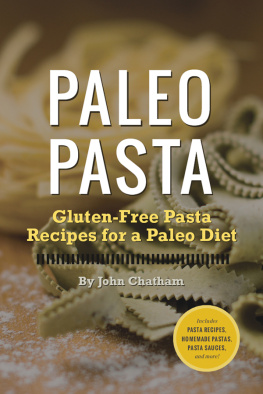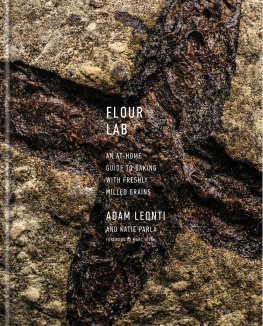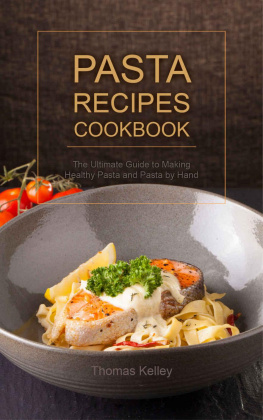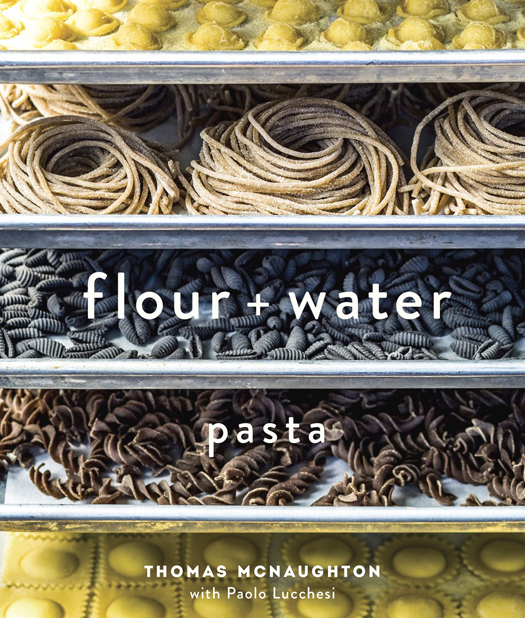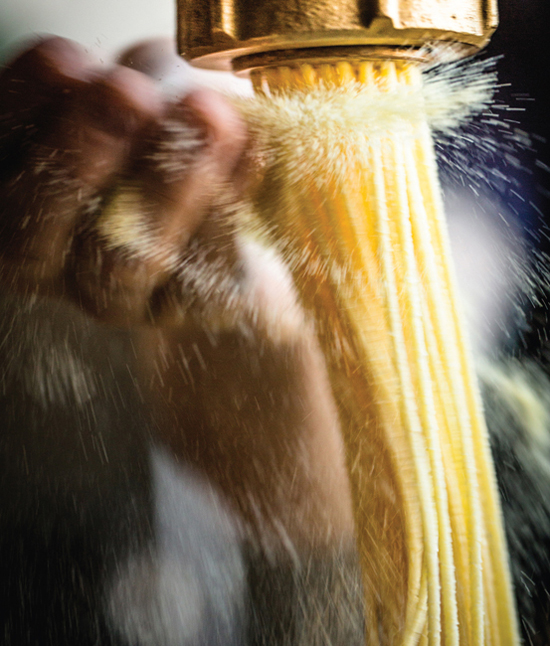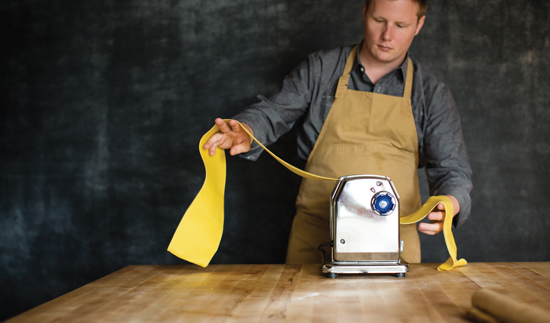Copyright 2014 by Thomas McNaughton
Photographs copyright 2014 by Eric Wolfinger
All rights reserved.
Published in the United States by Ten Speed Press, an imprint of the Crown Publishing Group, a division of Random House LLC, New York, a Penguin Random House Company.
www.crownpublishing.com
www.tenspeed.com
Ten Speed Press and the Ten Speed Press colophon are registered trademarks of Random House LLC.
Library of Congress Cataloging-in-Publication Data
McNaughton, Thomas.
Flour + water : pasta / Thomas McNaughton.
pages cm
ISBN 978-1-60774-470-2 (hardcover) ISBN 978-1-60774-471-9 (ebook)
1. Cooking (Pasta) I. Title. II. Title: Pasta. III. Title: Flour and water.
TX809.M17M43 2014
641.822dc23
2014015936
v3.1
CONTENTS
PREFACE: THE ORIGINS
David Steele and David White
I wrote the original one-page business plan for Flour + Water on the back of an envelope, over a decade before the restaurant actually became a reality. It started with a simple premise: In Italy, I saw how pasta was used as a delivery agent for seasonal ingredients; pizza took the same approach. Coming from the East Coast of the United States, where pasta sauces and menus stayed the same 365 days a year, this was an eye-opening experience for me. David Steele
I grew up in Ireland, in a village of sixteen hundred people. It was your classic small town in the Irish countryside: It had a couple of churches, a town square, one dentist, two lawyers, two doctors, and ten pubs. When we had a full house, there were eight people at the dinner table: Mum and Dad and six of us siblings. Dining together was a part of our life, mostly because our father insisted that we come together at the table every day. My mother is a great cook, and our meals were always wholesome and delicious. There were always potatoes, and sometimes multiple potato dishes at onceeverything that youd expect from a rural Irish family. David White
I grew up in New Jersey, coincidentally about fifteen miles from where Tom was raised. I put myself through college by working in restaurants. I started as a dishwasher at the age of sixteen and worked my way up to a prep cook. The higher up the ladder I got, the more quickly I realized that kitchen life is a very tough life. At the same time, I saw servers in the front of house working fewer hours and making more money. So I did the logical thing and moved out of the kitchen. I became a busboy, and by age eighteen I was managing an Italian restaurant in Wildwood, New Jersey.
I went to college not very far from my Jersey roots, at Temple University in Philadelphia. During that period, I waited tables at some of the best restaurants in the city. Most of those that know me have no idea, but I came inches from dropping out of college to go to culinary school. My dad talked me out of that plan. Instead, I graduated from college and went straight to Wall Street, still continuing to wait tables on the weekends. In all, I spent about eight years straight doing hard-core restaurant work.
I loved the restaurant industry but was shocked how most of the restaurants I worked at werent run like real businesses. There was no awareness of food costs or labor costs, and most strikingly, there was no overarching strategy. Most restaurants I witnessedincluding some very good onesjust planned on figuring it out as they went along. Eventually, with a little more seniority on Wall Street, I stopped waiting tables on the side. I vowed to return to the restaurant business and do it my way.
I spent my teenage years with the Jesuits at a boarding school, where they fed me big fat wedges of ham, the fat cap still unshaven, firm and bristly. Then I went to college in Dublin, intermittently working toward a liberal arts degree in history and Greek and Roman civilization. My rationale at the time, as a reluctant student, was that I might as well study something interesting that would lure me to a lecture here and there. By the time I graduated, I was itching to leave Ireland. Still naive and idealistic, I had the travel bug, bad. I wanted to see the world.
To travel, I would need employment. I figured that if I could wait tables, I would be able to work anywhere. And thats how I started in this business. Out of school, I got a job in a semi-decent restaurant in the heart of Dublin. It was named Gotham Cafe. As fate would have it, its specialty was pizza and pasta.
I ended up in the States kind of by accident. One day my older brother told me he was going to apply for one of the U.S. visas advertised in the paper. I asked him to put one in for me while he was at it. He did. I was chosen in the lottery, and he was not.
I had connections in New York, Boston, Chicago, and San Francisco. New York? I didnt want to go there. I was already burning the candle at both ends in Dublin. I needed to mellow out and figured New York would probably be a bad idea. Boston? Back then, I thought of Boston as a place with too much of a connection to Ireland; I wanted something different. And Chicago? I remember reading about a car that froze in a street at fourteen degrees below zero or something like that; no way was I enduring those extreme seasons.
California just seemed the coolest place. Everything I read about San Francisco was appealing, and it was the exact pace I was looking for. On top of that, a dear college friend made the offer of a couch upon which to surf. The decision was made.
When I arrived in California from New York, I had been working on Wall Street for nearly two decades. I was ready to finally pursue the restaurant idea. The concept of ubiquitous super-seasonality was something I had only witnessed in southern Europe. But in the Bay Area, I saw the influences of Chez Panisse and Zuni Caf, basically doing the same thing that the Italians did. Chief among those places was LuLu, Reed Hearons Provenal restaurant in SoMa. In my opinion, Reed Hearon is the most influential and underrated chef in San Francisco cuisinenot California cuisine as a whole, but San Francisco. He took the things that Alice Waters and Judy Rodgers were doing and made it his own.
Eating at LuLu changed my life. There was seasonality, a giant hearth, and a menu of wood-fired pizzas, truly great pastas, and the now-signature dish of mussels on a sizzling hot cast-iron plate. It was brilliant, and he was doing it twenty years before every single one of those components became trendy.
After rejections from dozens and dozens of restaurants around San Francisco, it became crystal clear to me how hard it is to get a job fresh off the boat. Restaurants were just not that into a guy without experience in this country, let alone this town. I finally ended up getting a job as a busboy in the bar at Postrio, Wolfgang Pucks famous Union Square spot. (I will never forget the guy who hired me, giving me my first job in the United States: Kim Beto.) It was 1997, when Postrio was at the tail end of its greatness but still a very good and professional restaurant. I was promoted to a barback a few months later, and then to the service bartender for the breakfast shift. It was great; I received wine deliveries and organized the cellar, and was exposed to a top-tier wine program. Behind the bar, I was rocking the blender and serving Ramos fizz cocktails to the blue hairs who trekked down from Nob Hill.


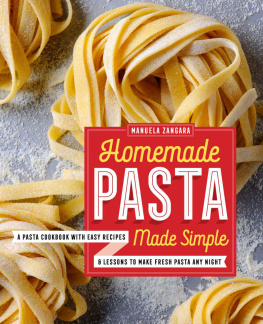
![Missy Robbins - Pasta : The Spirit and Craft of Italys Greatest Food, with Recipes [A Cookbook]](/uploads/posts/book/300525/thumbs/missy-robbins-pasta-the-spirit-and-craft-of.jpg)

